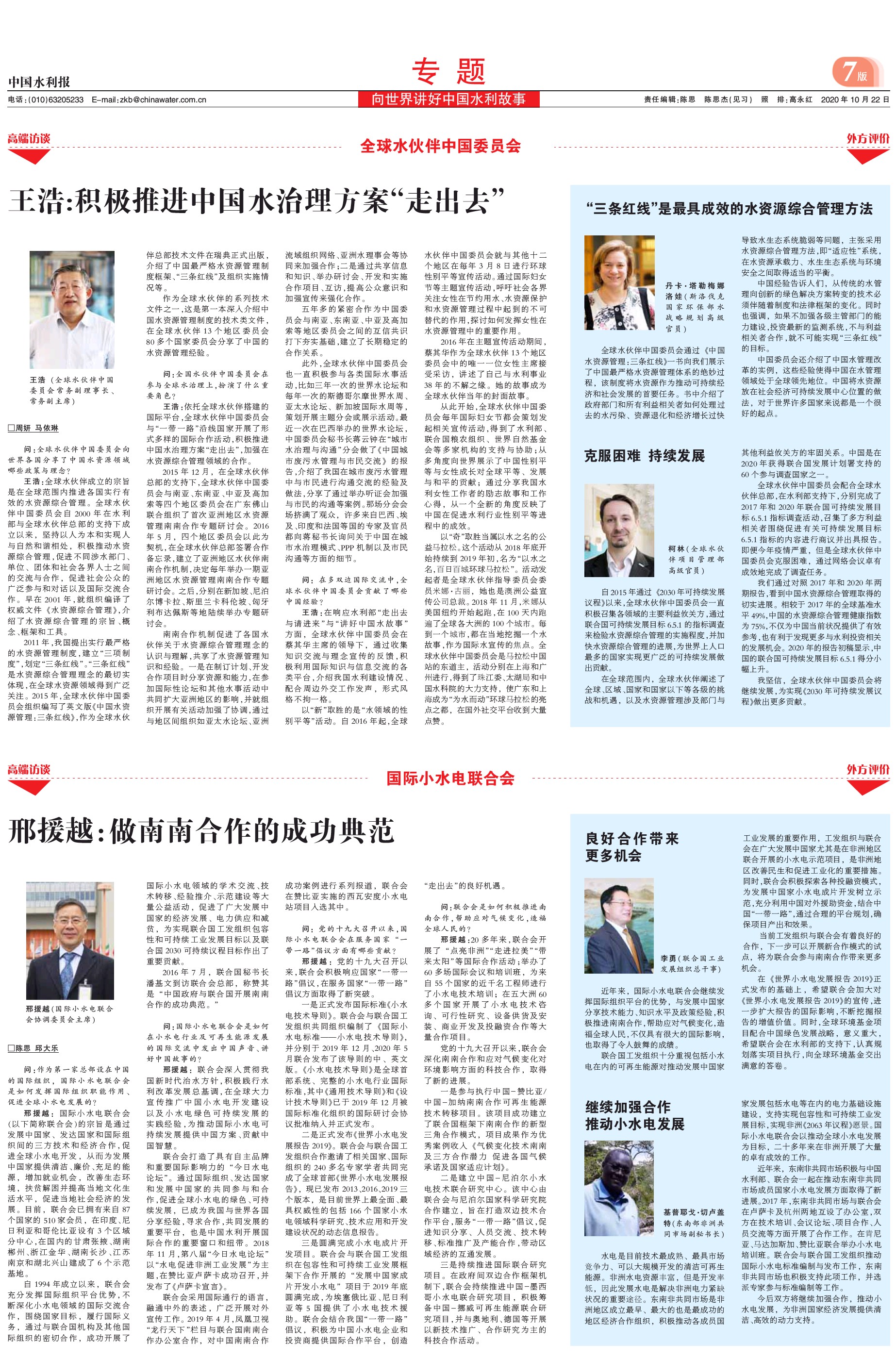(The following is excerpted in the China Water News publishing on October 22 and November 5.)
China Water News: How GWP China facilitates stakeholders to exchanges water polices and management skills at regional and global levels?
 Hao Wang, GWP China Vice Chair
Hao Wang, GWP China Vice Chair
In two months, GWP, founded in 1996, will celebrate its 25th Anniversary. As one of 13 regional partnerships, GWP China has promoted the integrated management of water resources (IWRM), the soul of GWP for two decades since its establishment. We have committed to the sustainable development of water related resources and harmonious relationship between people and nature.
As the first advocate of IWRM, GWP has a bunch of knowledge resources in this regard, telling people how to achieve a rational management of water and GWP launched the publication named ‘IWRM’ in 1996. Over 25 years, its principles and tools have been adopted by governments, NGOs, communities, and media. GWP China has contributed to this pursuit after translating IWRM in Chinese for disseminations in 2000. And 15 years later, with support of GWP TEC, we published "China’s Water Resources Management: Three Red Lines" that introduces how China adopts IWRM in regulations and legal framework. GWP network enables China’s water outcomes to share with 85 countries in 13 regions. Now IWRM is a popular concept and SDG 6 edits it with indicators that provides national authorities with concrete assessment standards. GWP China has involved in SDG 6 monitoring progress as well.
In additional to the said publications, GWP has explored diverse platforms to tell water-related stories in the world. Each year, we put ‘March 22-World Water Day’ on schedule and ‘March-8 Women Day’ as well to promote women’s engagement and influence in water sector. GWP China’s Chair, Mdm. Qihua Cai is the ONLY female top leader in thirteen GWP regions. She also joined ‘GWP Women’s Day’ campaign for inspiring more female professionals to invest their talents for water management and development. Danka Thalmeinerova, Senior Officer, Strategic Water Planning Department, Ministry of Environment Slovakia
Danka Thalmeinerova, Senior Officer, Strategic Water Planning Department, Ministry of Environment Slovakia
GWP Technical Focus Paper: China's Water Resources Management Challenge: The 'three red lines'.
This technical paper is an excellent journey of China’s approach to developing a new, stringent water resources management system that puts water as the first priority in the drive for sustainable economic and social development. The paper is a critical overview how the government and all stakeholders addressed the past water pollution, resources degradation and enormous economic growth that deprived fragile water ecosystems.
The paper advocates for integrated water resources management approach - a system which is ‘fit for purpose’ and provides the right balance between the bearing capacity of the water resources, aquatic ecosystems and environmental safety.
The key message of this paper is that shifts in technologies from traditional water management towards innovative and green solutions must be accompanied with changes in institutional and legal set up. The paper emphasizes that the implementation of the national strategy of “three red lines” water use, water use efficiency, and water pollution would not be possible without efforts to build capacities of authorities at all levels, investing in up-to-date monitoring systems, and cooperation with all stakeholders.
Lessons learnt in Chinese example of water management reform places the China on the top of global player in water management. Water challenges facing China and the steps being taken to put water at the center of sustainable social and economic development are a good starting point for many other nations in the world. Colin Herron, Global Coordinator, Water Solutions for the SDGs
Colin Herron, Global Coordinator, Water Solutions for the SDGs
Since the adoption of the 2030 Agenda for Sustainable Development in 2015, GWP China has been an active convener of key stakeholders from different sectors to both monitor progress on SDG indicator 6.5.1, the degree of implementation of integrated water resources management (IWRM), and also to accelerate progress on IWRM, as a contribution to broader sustainable development in the world’s most populous country.
Around the world, GWP’s multi-level approach, articulating global, regional, national and sub-national challenges and opportunities, and its strong relationships with mandated institutions and other relevant stakeholders in water resources management, effectively allows local water-related challenges and opportunities to be highlighted as input into global processes such as the SDGs, and for those global processes to in turn boost progress on local water issues. Thus, China is one of 60 countries being assisted by GWP in 2020, on behalf of the SDG 6 IWRM Support Programme, to convene a multi-stakeholder consultation to facilitate reporting on SDG indicator 6.5.1.
In China, GWP was able to follow a similar process in both 2017 and 2020, shedding an interesting light upon the genuine progress achieved on IWRM between the two reporting periods. In 2020, given the current health pandemic, this was efficiently achieved through successive digital consultations. As compared to the global 2017 baseline of 49%, China’s healthy IWRM score of 75% not only provided a useful snapshot of China’s current situation, but also allowed areas of opportunity for progress to be identified, on which GWP China has been able to facilitate effective investments in water-related development. Thus, the provisional 2020 results in China show an increase under this SDG 6.5.1 score, which I have no doubt that GWP China will continue to build upon in the coming years, to contribute to the achievement of the 2030 Agenda. 
